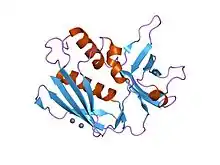Enterotoxin type B
In the field of molecular biology, enterotoxin type B, also known as Staphylococcal enterotoxin B (SEB), is an enterotoxin produced by the gram-positive bacteria Staphylococcus aureus. It is a common cause of food poisoning, with severe diarrhea, nausea and intestinal cramping often starting within a few hours of ingestion.[1] Being quite stable,[2] the toxin may remain active even after the contaminating bacteria are killed. It can withstand boiling at 100 °C for a few minutes.[1] Gastroenteritis occurs because SEB is a superantigen, causing the immune system to release a large amount of cytokines that lead to significant inflammation.
| Enterotoxin type B | |||||||
|---|---|---|---|---|---|---|---|
| Identifiers | |||||||
| Organism | |||||||
| Symbol | entB | ||||||
| UniProt | P01552 | ||||||
| |||||||
| Staphylococcal/Streptococcal toxin, N-terminal domain | |||||||||
|---|---|---|---|---|---|---|---|---|---|
 Crystal structure of the superantigen Spe-H (zinc bound) from Streptococcus pyogenes | |||||||||
| Identifiers | |||||||||
| Symbol | Staphylococcal/Streptococcal toxin, N-terminal domain | ||||||||
| Pfam | PF01123 | ||||||||
| InterPro | IPR006173 | ||||||||
| PROSITE | PDOC00250 | ||||||||
| SCOP2 | 1se3 / SCOPe / SUPFAM | ||||||||
| |||||||||
| Staphylococcal/Streptococcal toxin, beta-grasp domain | |||||||||
|---|---|---|---|---|---|---|---|---|---|
| Identifiers | |||||||||
| Symbol | Stap_Strp_tox_C | ||||||||
| Pfam | PF02876 | ||||||||
| InterPro | IPR006123 | ||||||||
| PROSITE | PDOC00250 | ||||||||
| SCOP2 | 1se3 / SCOPe / SUPFAM | ||||||||
| |||||||||
Additionally, this protein is one of the causative agents of toxic shock syndrome.
Function
The function of this protein is to facilitate the infection of the host organism. It is a virulence factor designed to induce pathogenesis.[3] One of the major virulence exotoxins is the toxic shock syndrome toxin (TSST), which is secreted by the organism upon successful invasion. It causes a major inflammatory response in the host via superantigenic properties, and is the causative agent of toxic shock syndrome. It functions as a superantigen through activation of a significant fraction of T-cells (up to 20%) by cross-linking MHC class II molecules with T-cell receptors. TSST is a multisystem illness with several symptoms such as high fever, hypotension, dizziness, rash and peeling skin.[3]
Structure
All of these toxins share a similar two-domain fold (N and C-terminal domains) with a long alpha-helix in the middle of the molecule, a characteristic beta-barrel known as the "oligosaccharide/oligonucleotide fold" at the N-terminal domain and a beta-grasp motif at the C-terminal domain. Each superantigen possesses slightly different binding mode(s) when it interacts with MHC class II molecules or the T-cell receptor.[4]
N-terminal domain
The N-terminal domain is also referred to as OB-fold, or in other words the oligonuclucleotide binding fold. This region contains a low-affinity major histocompatibility complex class II (MHC II) site which causes an inflammatory response.[5]
The N-terminal domain contains regions involved in Major Histocompatibility Complex class II association. It is a five stranded beta barrel that forms an OB fold.[6][7][8]
C-terminal domain
The beta-grasp domain has some structural similarities to the beta-grasp motif present in immunoglobulin-binding domains, ubiquitin, 2Fe-2 S ferredoxin and translation initiation factor 3 as identified by the SCOP database.
References
- "eMedicine - CBRNE - Staphylococcal Enterotoxin B". eMedicine. Retrieved 2011-02-06.
- Nema V, Agrawal R, Kamboj DV, Goel AK, Singh L (June 2007). "Isolation and characterization of heat resistant enterotoxigenic Staphylococcus aureus from a food poisoning outbreak in Indian subcontinent". Int. J. Food Microbiol. 117 (1): 29–35. doi:10.1016/j.ijfoodmicro.2007.01.015. PMID 17477998.
- Blomster-Hautamaa DA, Kreiswirth BN, Kornblum JS, Novick RP, Schlievert PM (November 1986). "The nucleotide and partial amino acid sequence of toxic shock syndrome toxin-1". J. Biol. Chem. 261 (33): 15783–6. doi:10.1016/S0021-9258(18)66787-0. PMID 3782090.
- Acharya KR, Papageorgiou AC, Tranter HS (1998). "Crystal structure of microbial superantigen staphylococcal enterotoxin B at 1.5 A resolution: implications for superantigen recognition by MHC class II molecules and T-cell receptors". J. Mol. Biol. 277 (1): 61–79. doi:10.1006/jmbi.1997.1577. PMID 9514739.
- Brosnahan AJ, Schlievert PM (December 2011). "Gram-positive bacterial superantigen outside-in signaling causes toxic shock syndrome". FEBS J. 278 (23): 4649–67. doi:10.1111/j.1742-4658.2011.08151.x. PMC 3165073. PMID 21535475.
- Prasad GS, Earhart CA, Murray DL, Novick RP, Schlievert PM, Ohlendorf DH (December 1993). "Structure of toxic shock syndrome toxin 1". Biochemistry. 32 (50): 13761–6. doi:10.1021/bi00213a001. PMID 8268150.
- Acharya KR, Passalacqua EF, Jones EY, Harlos K, Stuart DI, Brehm RD, Tranter HS (January 1994). "Structural basis of superantigen action inferred from crystal structure of toxic-shock syndrome toxin-1". Nature. 367 (6458): 94–7. Bibcode:1994Natur.367...94A. doi:10.1038/367094a0. PMID 8107781. S2CID 4235964.
- Prasad GS, Radhakrishnan R, Mitchell DT, Earhart CA, Dinges MM, Cook WJ, Schlievert PM, Ohlendorf DH (June 1997). "Refined structures of three crystal forms of toxic shock syndrome toxin-1 and of a tetramutant with reduced activity". Protein Sci. 6 (6): 1220–7. doi:10.1002/pro.5560060610. PMC 2143723. PMID 9194182.